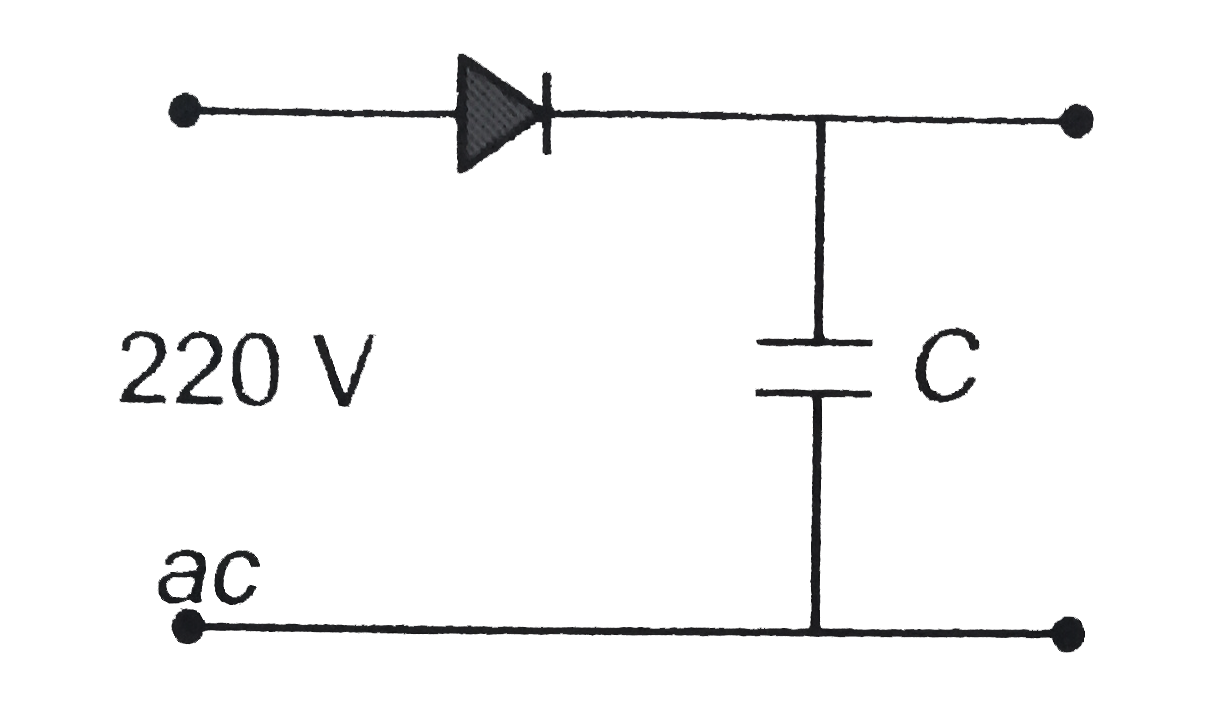Let q be the charge on the capacitor at any time t. The voltage V across the capacitor is
Vmsinωt=qC
Vmcosωt=2VC
Vmcosωt=q2C
Vmsinωt=2qC
The correct Answer is:A
Similar Questions
A charged capacitor and an inductor are connected in series at time t= 0. In terms of the period T of the resulting oscillations. determine how much later the following reach their maximum value: (a) the charge on the capacitor, (b) the voltage across the capacitor, with its original polarity: (c) the energy stored in the electric field, and (d) the current.
View SolutionFour capacitors are arranged as shown. All are initially uncharged. A 30 V battery is palced across terminal PQ to charge the capacitors and is then removed. The voltage across the terminals RS is then (in volt)
 View Solution
View Solution
Knowledge Check
- Question 1 - Select One
A diode is connected to 220V(rms) ac in series with a capacitor as shown in fig. The voltage across the capacitor is
 A220VB110VC311.1VD220√2V
A220VB110VC311.1VD220√2V - Question 2 - Select One
The circuit shown has been connected for a long time. The voltage across the capacitor is
 A1.2VB2.0 VC2.4VD4.0 V
A1.2VB2.0 VC2.4VD4.0 V - Question 3 - Select One
Four capacitors are arranged as shown. All are initially uncharged. A 30 V battery is palced across terminal PQ to charge the capacitors and is then removed. The voltage across the terminals RS is then (in volt)
 A10B20C30D40
A10B20C30D40
A battery is used to charge a parallel plate combination of two identical capacitors. If the potential difference across the battery is V and the total charge Q flows through the battery during the charging process then 1) The charge on each capacitor is Q/2 and the potential of each capacitor is V/2 2) The charge on each capacitor is Q and the potential of each capacitor is V 3) The charge on each capacitor is Q/2 and the potential of each capacitor is V 4) The charge on each capacitor is Q and the potential of each capacitor is V/2
View SolutionA 200Ω resistor is connected in series with a 5(μ)F capacitor. The voltage across the resistor is VR=(1.20V)cos(2500rads−1)t.
(a) Derive an expression for the circuit current.
(b) Determine the capactive reactance of the capacitor.
(c ) derive an experssion for the voltage across the capacitor.View SolutionA capacitor of capacitance 4μF is fully charged to a potential difference of 12 V and then charging battery is disconnected. Charged capacitor is now connected across an inductor of self-inductance of 1.2 mH. The current in the circuit at a time when the potential difference across the capacitor is 6 V is
View SolutionA 5μF capacitor is fully charged across a 12 V battery, It is then disconnected from the battery and connected to an uncharged capacitor, If the voltage across the capacitor becomes 3 V then the capacitance of the
View SolutionA 8μF capacitor is fully charged across a 12V battery, it is then disconnected from the battery and connected to an uncharged capacitor. If the voltage across the capacitor becomes 3V, then the capacitance of the uncharged capacitor will be
View Solution

